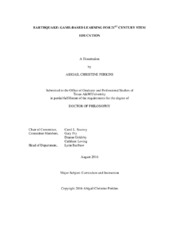| dc.description.abstract | To play is to learn. A lack of empirical research within game-based learning literature, however, has hindered educational stakeholders to make informed decisions about game-based learning for 21st century STEM education. In this study, I modified a research and development (R&D) process to create a collaborative-competitive educational board game illuminating elements of earthquake engineering. I oriented instruction- and game-design principles around 21st century science education to adapt the R&D process to develop the educational game, Earthquake. As part of the R&D, I evaluated Earthquake for empirical evidence to support the claim that game-play results in student gains in critical thinking, scientific argumentation, metacognitive abilities, and earthquake engineering content knowledge. I developed Earthquake with the aid of eight focus groups with varying levels of expertise in science education research, teaching, administration, and game-design. After developing a functional prototype, I pilot-tested Earthquake with teacher-participants (n=14) who engaged in semi-structured interviews after their game-play. I analyzed teacher interviews with constant comparison methodology. I used teachers’ comments and feedback from content knowledge experts to integrate game modifications, implementing results to improve Earthquake. I added player roles, simplified phrasing on cards, and produced an introductory video. I then administered the modified Earthquake game to two groups of high school student-participants (n = 6), who played twice.
To seek evidence documenting support for my knowledge claim, I analyzed videotapes of students’ game-play using a game-based learning checklist. My assessment of learning gains revealed increases in all categories of students’ performance: critical thinking, metacognition, scientific argumentation, and earthquake engineering content knowledge acquisition. Players in both student-groups improved mostly in critical thinking, having doubled the number of exhibited instances of critical thinking between games. Players in the first group exhibited about a third more instances of metacognition between games, while players in the second group doubled such instances. Between games, players in both groups more than doubled the number of exhibited instances of using earthquake engineering content knowledge. The student-players expanded use of scientific argumentation for all game-based learning checklist categories. With empirical evidence, I conclude play and learning can connect for successful 21st century STEM education. | en |


